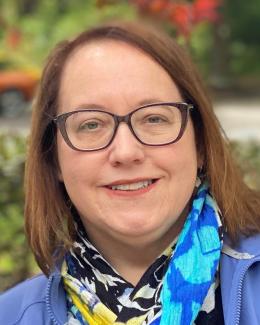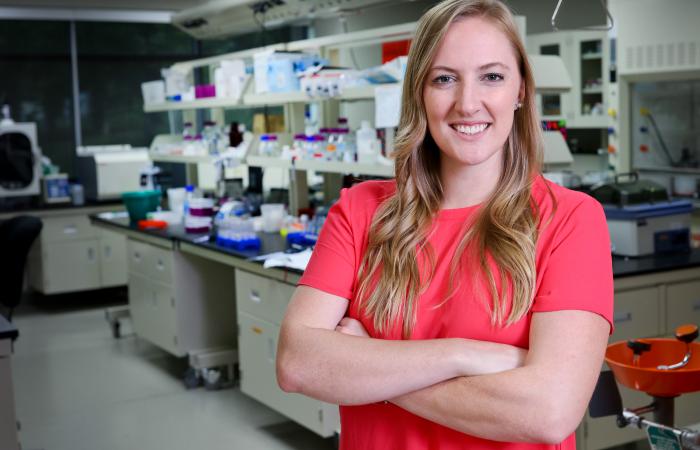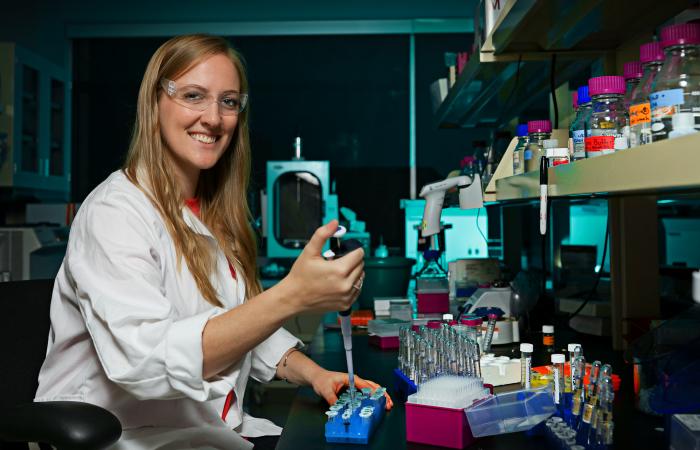Mallory Ladd began trekking to the Arctic even before her time at Oak Ridge National Laboratory (ORNL), in search of a better understanding of what’s going on belowground and how it links to changes in the larger landscape.
The University of Tennessee, Knoxville (UTK) Bredesen Center student recently finished her third trip to Alaska to collect field data for the Next Generation Ecosystem Experiments-Arctic (NGEE-Arctic) program, supported by the U.S. Department of Energy’s Office of Biological and Environmental Research. The program harnesses the expertise of more than 140 scientists from national labs and universities studying how permafrost thaw may affect regional and global climate systems.
Ladd is using her capabilities in analytical chemistry and mass spectrometry to examine how soil water chemistry is changing in the Arctic because of warming and thawing conditions, in order to better inform earth science models. She has been exploring those changes since her undergraduate days researching Arctic soil nitrogen at the University of Toledo.
“Chemists usually spend a lot of time in the lab,” Ladd said. “But with this type of research I’m encouraged to get out and collect samples in the field. I feel closer to the science questions that way; working from sample collection to data analysis, from start to finish, has been enlightening.”
Her path to the Arctic began at Toledo as the result of a chance encounter with Professor Mike Weintraub, who had just received funding from the National Science Foundation (NSF) to examine seasonality in the Arctic. Ladd was a senior at the university at the time, watching a screening of the documentary Dirt! with a friend. “We were talking about how interesting the movie was, how important the nutrient profile and soil chemistry are to so many things, when Mike joined in the conversation and told us he was looking for a lab technician with a chemistry background to join his team,” said Ladd. She worked with Weintraub for two years, visiting the Arctic twice for sampling as she studied soil nitrogen availability and impacts on plant life.
Advancing science with cutting-edge instruments
The work greatly influenced where Ladd would go for her doctoral studies. She was attracted to the Bredesen Center for Interdisciplinary Research & Graduate Education for its close ties to the national lab and the NGEE-Arctic program led by ORNL Environmental Sciences Division Director Stan Wullschleger—as well as by the offer of a personalized Ph.D. program that allows her to pursue science and a parallel track in policy. She began her time with ORNL and UTK in 2013, and is currently pursuing a doctorate in energy science and engineering. She is also an NSF Graduate Research Fellow.
Wullschleger and UTK adviser Robert Hettich, a scientist in the Mass Spectrometry/Laser Spectroscopy Group at ORNL, helped Ladd design a program around Arctic metabolomics. In this focus area, she studies small molecules in the soil—how they are transported and break down over time, and how soil chemistry changes as temperatures rise.
“Much of the success with this research is owed to being at ORNL with all the cutting-edge technologies it offers. The mass spectrometry resources here have been integral to getting high-resolution measurements in a short amount of time,” Ladd said.
Her work for NGEE-Arctic started out in Barrow, Alaska, a coastal plain environment that has interesting microtopography where the soil physically moves as it freezes and thaws, creating rifts and valleys in the landscape. This summer, NGEE-Arctic conducted sampling in Nome, a sub-Arctic region that has undergone more warming and has markedly different, abundant plant life compared with Barrow.
“My work at ORNL has allowed me to connect my fundamental scientific questions with DOE deliverables,” Mallory said. “It’s a great time to advocate for science, and to make sure we have strong, motivated young scientists doing excellent work.”
Supporting the next generation of scientists
Ladd has been very active in supporting her peers. She maintains a blog, “Think Like a Postdoc,” that chronicles her work and dispenses advice to other students.
She also founded a student group at UTK called Pipeline: Vols for Women in STEM. A part of the university’s Commission for Women, the group works to enhance the status and representation of women in the 50-plus science, technology, engineering, and math fields at UTK through events such as an annual research symposium, interdisciplinary mentoring, monthly lectures, community outreach, and professional and social networking events.
“The name ‘Pipeline’ refers to the analogy often used to describe the phenomenon that young girls and women are shown to be just as interested and scoring just as high as boys and men in STEM areas in K-12 and as college undergrads. But after graduating we see a divergence in the gender balance where men start to dominate these fields, often referred to as the leaky pipeline,” she said. Research in the past decade has discarded the notion that those changes happen because women start having children or are not “cut out” for long hours, she added.
“Instead, studies are showing that the culprit is unconscious, or implicit, biases at the systemic level that are discouraging women from pursuing these careers as compared to their white male counterparts. The numbers are even worse for women of color, and especially at the leadership level,” she said. The Pipeline group tracks statistics on gender distribution in STEM areas at the university and aims to reverse that trend.
Ladd’s curiosity and questioning nature began early. “I always questioned everything, and my parents were a huge part of that. They always encouraged me to not be afraid of standing out and to challenge the status quo. Science has been an outlet for that tendency,” she said. “I like the phrase that science turns ‘I don’t know’ into ‘I don’t know yet.’”
Ladd grew up playing volleyball, with siblings who played rugby and soccer—meaning a lot of time on the road with various teams. “Our parents always told us it was okay to play in the dirt,” she said. Today away from the lab, she continues to spend time outdoors, kayaking, biking, and rock climbing, adding, “I’m a huge advocate for grad students making time for outside interests.”
ORNL is managed by UT-Battelle for DOE’s Office of Science, the single largest supporter of basic research in the physical sciences in the United States. DOE’s Office of Science is working to address some of the most pressing challenges of our time. For more information, please visit energy.gov/science.




